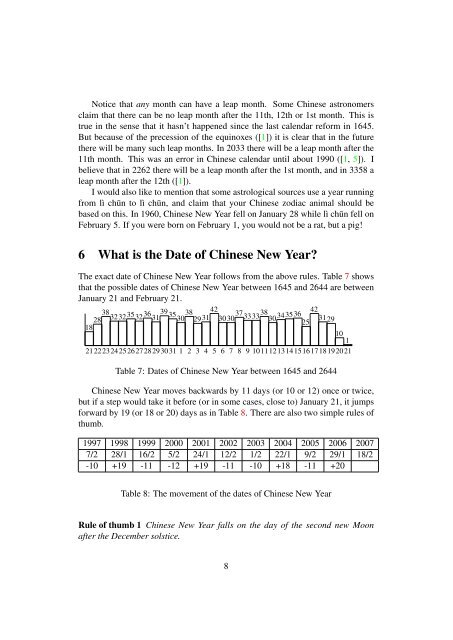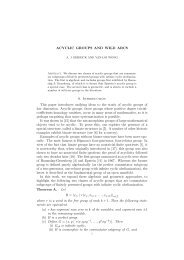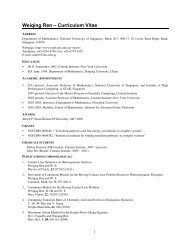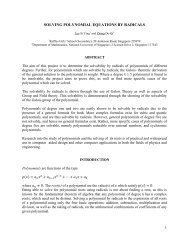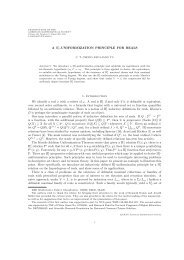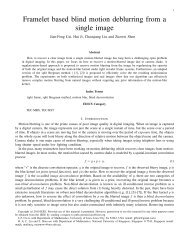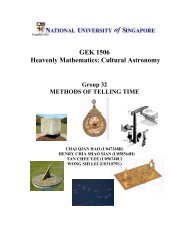When is Chinese New Year? - Department of Mathematics
When is Chinese New Year? - Department of Mathematics
When is Chinese New Year? - Department of Mathematics
You also want an ePaper? Increase the reach of your titles
YUMPU automatically turns print PDFs into web optimized ePapers that Google loves.
Notice that any month can have a leap month. Some <strong>Chinese</strong> astronomers<br />
claim that there can be no leap month after the 11th, 12th or 1st month. Th<strong>is</strong> <strong>is</strong><br />
true in the sense that it hasn’t happened since the last calendar reform in 1645.<br />
But because <strong>of</strong> the precession <strong>of</strong> the equinoxes ([1]) it <strong>is</strong> clear that in the future<br />
there will be many such leap months. In 2033 there will be a leap month after the<br />
11th month. Th<strong>is</strong> was an error in <strong>Chinese</strong> calendar until about 1990 ([1, 5]). I<br />
believe that in 2262 there will be a leap month after the 1st month, and in 3358 a<br />
leap month after the 12th ([1]).<br />
I would also like to mention that some astrological sources use a year running<br />
from lì chūn to lì chūn, and claim that your <strong>Chinese</strong> zodiac animal should be<br />
based on th<strong>is</strong>. In 1960, <strong>Chinese</strong> <strong>New</strong> <strong>Year</strong> fell on January 28 while lì chūn fell on<br />
February 5. If you were born on February 1, you would not be a rat, but a pig!<br />
6 What <strong>is</strong> the Date <strong>of</strong> <strong>Chinese</strong> <strong>New</strong> <strong>Year</strong>?<br />
The exact date <strong>of</strong> <strong>Chinese</strong> <strong>New</strong> <strong>Year</strong> follows from the above rules. Table 7 shows<br />
that the possible dates <strong>of</strong> <strong>Chinese</strong> <strong>New</strong> <strong>Year</strong> between 1645 and 2644 are between<br />
January 21 and February 21.<br />
38<br />
28 32 32353236<br />
39<br />
31<br />
35 38 42<br />
37<br />
30 2931<br />
30 30 33 33<br />
38<br />
42<br />
30343536<br />
31<br />
25<br />
29<br />
18<br />
10<br />
1<br />
2122232425262728293031<br />
1 2 3 4 5 6 7 8 9 101112131415161718192021<br />
Table 7: Dates <strong>of</strong> <strong>Chinese</strong> <strong>New</strong> <strong>Year</strong> between 1645 and 2644<br />
<strong>Chinese</strong> <strong>New</strong> <strong>Year</strong> moves backwards by 11 days (or 10 or 12) once or twice,<br />
but if a step would take it before (or in some cases, close to) January 21, it jumps<br />
forward by 19 (or 18 or 20) days as in Table 8. There are also two simple rules <strong>of</strong><br />
thumb.<br />
1997 1998 1999 2000 2001 2002 2003 2004 2005 2006 2007<br />
7/2 28/1 16/2 5/2 24/1 12/2 1/2 22/1 9/2 29/1 18/2<br />
-10 +19 -11 -12 +19 -11 -10 +18 -11 +20<br />
Table 8: The movement <strong>of</strong> the dates <strong>of</strong> <strong>Chinese</strong> <strong>New</strong> <strong>Year</strong><br />
Rule <strong>of</strong> thumb 1 <strong>Chinese</strong> <strong>New</strong> <strong>Year</strong> falls on the day <strong>of</strong> the second new Moon<br />
after the December solstice.<br />
8


